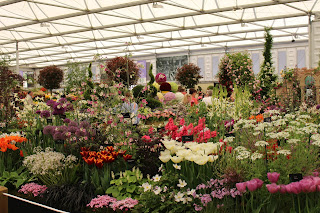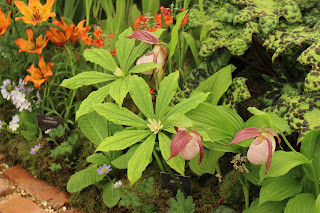A botanist at Chelsea Flower Show
 |
| Chelsea: an ocean of flowers |
It is my fifth time visiting the Chelsea
Flower Show, the biggest annual event in horticultural Britain. Every year I am
amazed by the sheer number and diversity of plants and flowers on display. I am
particularly perplexed by some totally out of season. I would not expect to see
autumn flowering Nerine in spring, and I have no idea how exhibitors manage to
keep Narcissus ‘February Gold’ in flower for such a long time. It is late May
after all.
 There are always the fabulous displays of
spring and summer flowers, each grower displaying a single genus and displayed
with great care and abundance. Particularly special are the peonies. How they
manage to keep these fragile flowers in bloom for the whole week, I do not
know, but the wall off pink, white, dark red and primrose yellow peonies displayed
by Primrose Hall Nursery (“every garden deserves a peony”) was simply
outstanding.
There are always the fabulous displays of
spring and summer flowers, each grower displaying a single genus and displayed
with great care and abundance. Particularly special are the peonies. How they
manage to keep these fragile flowers in bloom for the whole week, I do not
know, but the wall off pink, white, dark red and primrose yellow peonies displayed
by Primrose Hall Nursery (“every garden deserves a peony”) was simply
outstanding.  |
| Potatoes in all colours and shapes |
Every year there are stands with daffodils and tulips, dahlias
and lilies, delphiniums and begonias, fuchsias and roses, sweet peas and
alstroemerias, cacti and carnivorous plants, vegetable (yes, an entire stand of
potatoes!) and of course loads of orchids. I love orchids, and who can resist Avon Bulb’s display of lady-slipper orchids (Cypripedium) mixed with specialty Arisaema? Two square meters of Arisaema sikokianum, proudly showing off
their little white knobs: just wonderful. The Eric Young Orchid Foundation has
a particularly nice display of Oncidium
and intergeneric hybrids with the most amazing colours and patterns.
 |
| Sudamerlycaste locusta |
This is where the real botanising starts.
Of course, I like big blowsy flowers for display, but as a botanist, I am more
interested in the natural and rare. Thus, a green hooded orchid called Sudamerlycaste locusta gained my
attention. It has a beautiful pale-green fringe along the lip, which must have
reminded the author if this Peruvian species of a green locust. From the
cloudforests of Borneo hails Cleisocentron merrillianum, which was showing off
its curiously azure-blue clusters of flowers. You would really have to look out
for this little guy and avoid being attracted or distracted by the colourful
display of others beauties nearby. A Chelsea visit really is plant hunting in an ocean of flowers!
 |
| Utricularia quelchii |
The carnivorous plant displays are always
amazing, clumps of towering Sarracenia
pitchers, snake-headed Darlingtonia
and Nepenthes that look like a toilet seat are usually present. A clump of
flowering Venus’ fly trap (Dionaea
muscipula) was a lovely sight, holding its dainty flowers high above the
deadly traps so it does not catch its pollinating insects. Sometimes more
unusual carnivores can be found. Notoriously hard to grow and thus very rare in
horticulture are the epiphytic bladderworts, which have leathery leaves, tubers
and branches with minute bladder traps hidden in the moss on the trees. I have
seen these in the wild in South America, but never thought I would encounter Utricularia quelchii in Chelsea!
Unfortunately, no hummingbirds here to pollinate it, but there were many bees
and bumblebees that enjoyed the show, happily pollinating the poppies and
alliums on the various perennial plant displays.
 |
| Paris japonica with Lilium sachalinense (left) and Dysosma "Spotty Dotty" (upper right) |
Harperley Hall, all the way
from County Durham, had some unusual plants in their display and they deserve
my golden medal (if I had one to give). A selection of choice lilies. Dainty Lilium rubellum, fritillary-like L. mackliniae, tiger-spotted L. sachalinense and carmine L. pumilum were all jewels in their own
right. Then I spotted a flowering specimen of Paris japonica, the organism with the biggest genome on the planet
and hence a very slow grower and shy flowerer. Fringed by a Cypripedium and a lily it hardly stood
out, but it was a good find, as I had never seen it in flower and it sure is a
botanical oddity. It was hidden by a large clump of “Spotty Dotty” a complex hybrid
Dysosma (or Podophyllum, whatever taxonomy of Berberidaceae one prefers) with incredible
vigour and weird wine-red pendent flowers. It was a novelty a few years ago, but
has now become a staple of the woodland garden (it was present on four
different displays).
 |
| Primula sieboldii theatre |
Normally, regimented displays are not as
appealing to me as the more natural ones, but sometimes you find an exception.
A Japanese primrose theatre filled with rare selections of Primula sieboldii is one of these. These fragile woodland plants
are not what you would expect in such a setting, but I was told that this is
how they are usually displayed in Japan, including their bamboo labels and
paper-framed house. It sure reminded me of the P. auricula-theatres, which is a good British traditional way of
displaying its relatives, but I wonder if this tradition is so British after
all.
Fruit and vegetables are always interesting
to see how these are made interesting. The scent of strawberries drew me to one
stand, and I got a good tip from them. I should stake the strawberries on small
sticks off the ground, so that the pill bugs will not get to them. I am not
sure if I can manage to stake all of them, but I can give it a try with some and
see if it works. They sure had lovely strawberries!
 And then there are the colourful people. I
am always delighted to see people so excited about plants and flowers. It
really is a rarity, animals usually get more attention, and true, there were
some pandas (or actually people dressed in panda suits, but they were very
realistic from a distance) in the Chengdu Garden display that stole the show. A
dinosaur accompanied by a bodybuilding caveman was showing off his King Protea.
He also spoke fluent Italian, a classical language dating back to prehistoric
times. All great fun. There were the inevitable celebrities, Dawn French, Judy
Dench, Joan Collins, Monty Don, Roy Lancaster, with people flocking around
them.
And then there are the colourful people. I
am always delighted to see people so excited about plants and flowers. It
really is a rarity, animals usually get more attention, and true, there were
some pandas (or actually people dressed in panda suits, but they were very
realistic from a distance) in the Chengdu Garden display that stole the show. A
dinosaur accompanied by a bodybuilding caveman was showing off his King Protea.
He also spoke fluent Italian, a classical language dating back to prehistoric
times. All great fun. There were the inevitable celebrities, Dawn French, Judy
Dench, Joan Collins, Monty Don, Roy Lancaster, with people flocking around
them.
Chelsea is all about plants though, so time to admire some of the show gardens. I was pleased to see little lawn
and lots of native UK plants on show. Stretches of flowering native turf pink
with cuckoo flower and ox-eye daisies forming a backdrop for spectacular animal
statues made from driftwood (James Doran-Webb), the Welcome to Yorkshire garden
was fun with a little shoreline and lots of native Yorkshire plants and
M&G, sponsor of the event (their name was everywhere), aimed to make a
garden with native Maltese plants, although I though it looked more like weeds
on a graveyard. The Radio 2 gardens were lovely, particularly Zoe Ball’s
listening garden, a wilderness of sound, made visible in shallow ponds. Not
frog-friendly, but a great way to interact with the public.



Comments
Post a Comment